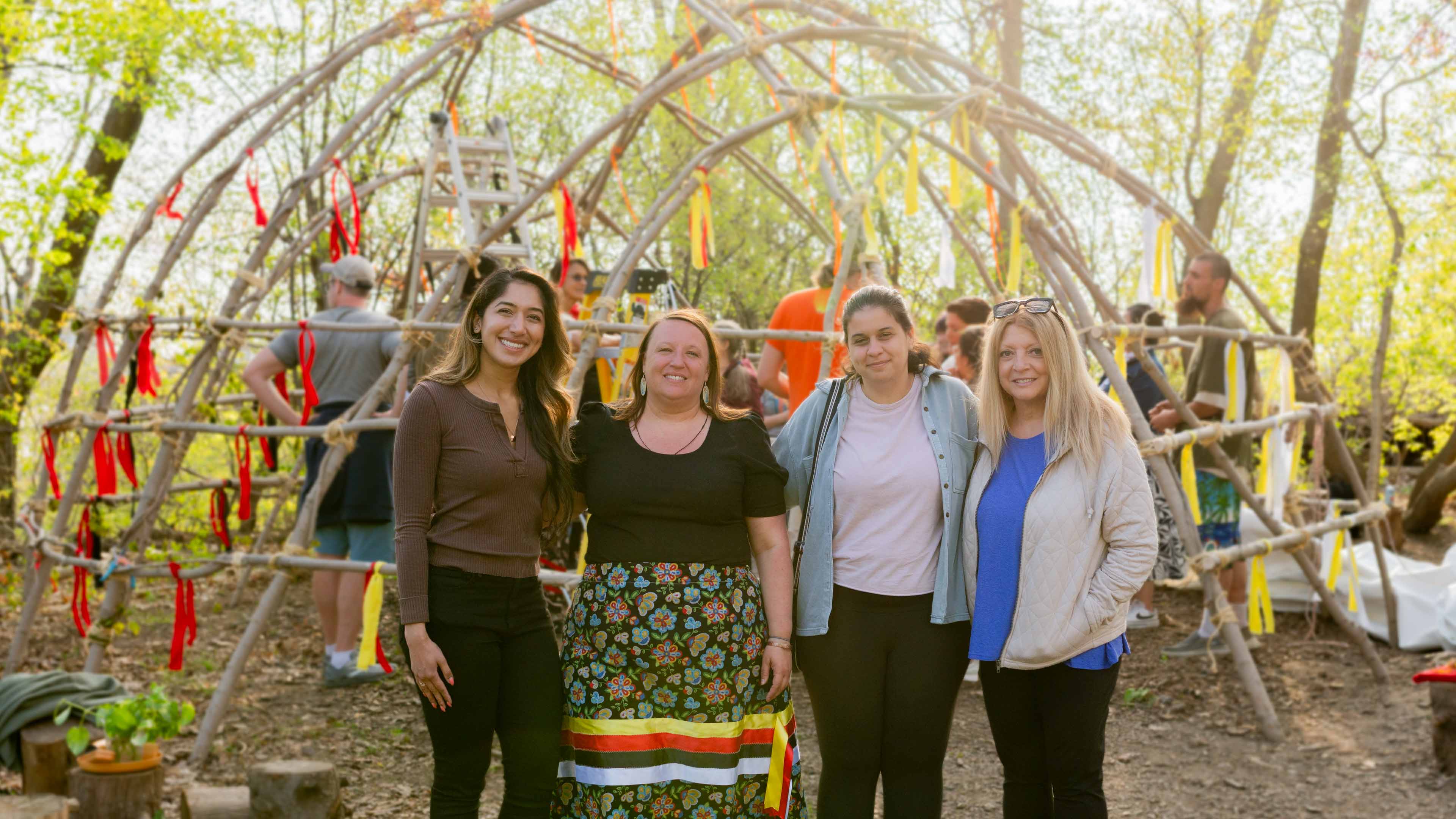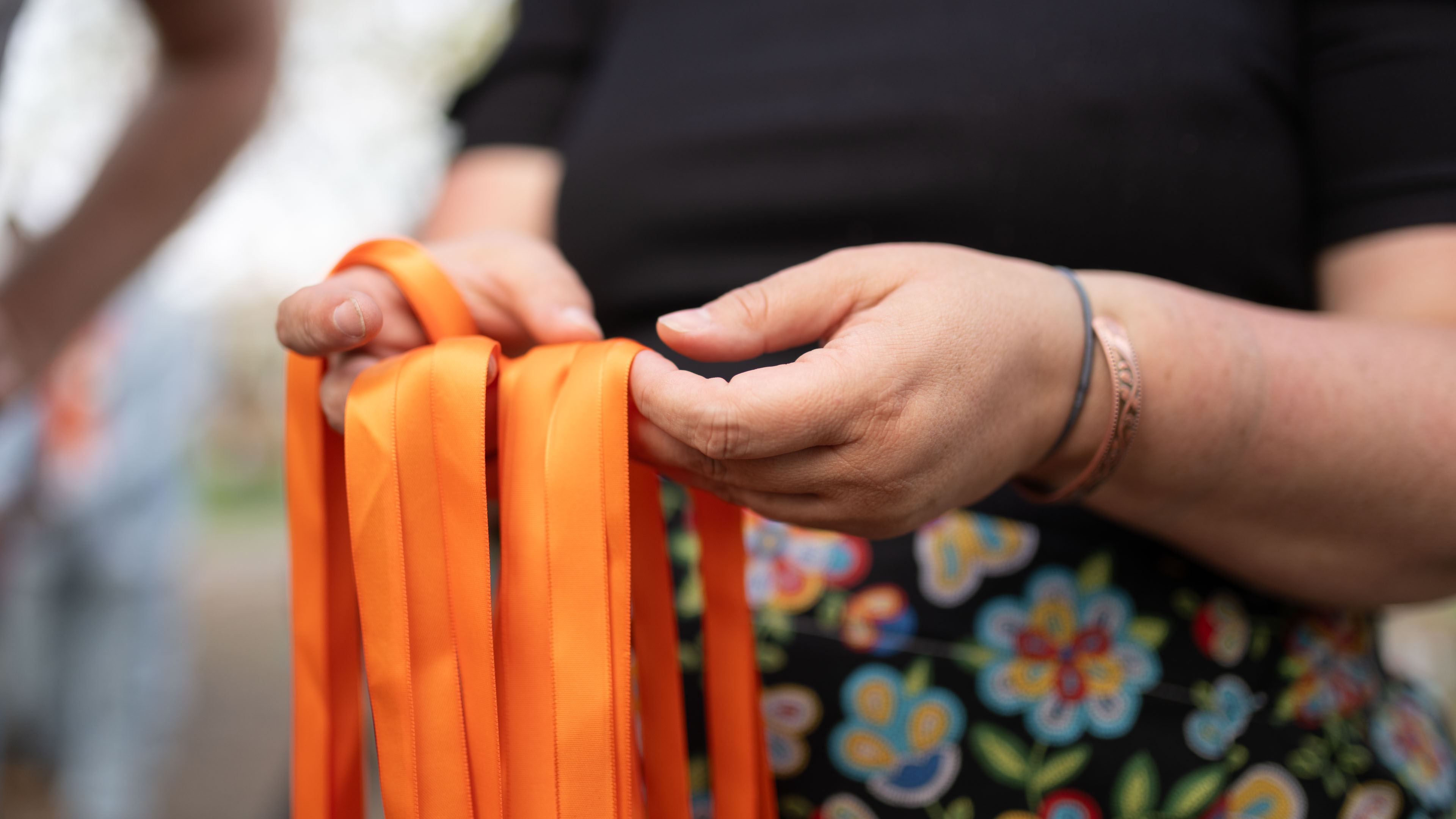
To “walk with children” is to love, guide, and support them. This Indigenous approach, filled with gentle kindness, enables children to grow up strong and with a sense of purpose. It’s about co-constructing realities together and learning from one another, and the idea thrives on the power of community.
The University of Guelph-Humber’s (U of GH) Early Childhood Studies (ECS) program has launched the Walking with Children project, a five-year initiative funded by the Calgary-based Flanagan Foundation to develop culturally grounded curriculum that supports Indigenous and non-Indigenous children and families. Led by Maya-Rose Simon, an Anishinaabeg from the Chippewa Tribe of Sault Ste. Marie, Mich., and professor at Humber Polytechnic, the project braids Indigenous worldviews of childhood, explores intergenerational learning, and centres the wisdom of Elders, Knowledge Holders, and community partners. A key focus is teaching students to bring children to the Land through Land-based education, where, as Simon shares, the Land — known in Indigenous teachings as “our Mother”— nurtures growth, belonging, and connection for all.
A key focus will be on Land-based pedagogy – designing and facilitating early learning experiences that are rooted on and with Land itself. It’s essential to create learning environments where Indigenous children feel seen, heard, respected, and safe, according to Dr. Elena Merenda, Acting Chair of ECS.
The rebuilding of the wiigiwaam at Silverthorne Early Learning Earth Centre was an important first step in the Walking with Children initiative as it supported a community partner in recreating a space for children, educators and families where they can connect to the Land. The construction of the new wiigiwaam brought together the Learning Enrichment Foundation, Odeminewiigiwaamgamik Society, the University of Guelph-Humber, the University of Waterloo, and visitors from the North Shore Mi’kmaq Early Learning Childcare.
The M’kade Ziibenhs (Black Creek) wiigiwaam build began in the morning with the harvesting of Maple saplings and concluded in ceremony. Wigwams are sacred places and the traditional homes of the Anishinaabeg. They represent traditional knowledge passed down through generations and serve as a symbol of community, home, and protection. This particular Odeminewiigiwaamgamik (Place of Learning From the Heart) M’kade Ziibenhs wiigiwaam, which was greatly beloved, collapsed from heavy snow cover in the winter, and the community was greatly saddened.
“[Rebuilding the wigwam meant] weaving together the threads of our traditional knowledge, in a way that was both powerful and deeply moving. It brought our community together in the most beautiful way. Children, their families, RECEs, Elders, Gookomiis (Grandmothers), Knowledge Holders, Lodge family members — even visitors from North Shore Mi’kmaq Early Years— all came together, gently bending Maple saplings into the sacred dome shape. With every hand that touched those branches and ribbons, hearts, spirits, bodies, and minds were carried into the dwelling,” said Simon.
“Growing up, I never had moments like this. This knowledge, these teachings, this way of being, was stolen from us. But through the Odeminewiigiwaamgamik Society, my children have now helped build two wiigiwaams! To witness and be part of this reclamation, to bring that loving, intentional way of life back into our present, is an honour beyond words. Being in community like this fills my heart in ways I can’t even describe. It reminds me that we are not just rebuilding a structure — we are rebuilding ourselves, our connections, and our future,” she said.

The wiigiwaam rebuild marked a day filled with teamwork and togetherness. This gathering was truly multigenerational, with children and Elders partaking, and included Indigenous peoples and non-Indigenous people too; all were welcomed.
“The rebuilding served as an act of reconnection – to culture, language, ceremony, and one another. It invited people to gather, to listen to teachings, and to engage in a process that honours relationship over transaction,” Dr. Merenda said, who helped rebuild the wiigiwaam. “For Indigenous peoples, the act of building together strengthens identity, reclaims traditions that were disrupted by colonization, and reaffirms that culture is alive and thriving. And for the University’s Early Childhood Studies (ECS) program, it offers a living, breathing example of Land-based pedagogy in action.”
Participating in the wiigiwaam rebuild was a powerful experience for ECS Program Support Coordinator Bianca Delicata, as she was educated and immersed in Indigenous ways of knowing and being. She noted that seeing children playing around the wiigiwaam, having games of hide-and-seek, rolling in the grass, and being surrounded by love was a special experience.
“We laughed, made connections, shared food, and enjoyed the cool breeze and sunshine. Every step was done with care – nothing was rushed, and there was no pressure or sense of obligation to work at any particular speed. Everyone’s energy felt intentional, and every hand played a role in bringing the wiigiwaam back to life. As I observed, it felt like watching an orchestra of bodies working in sync to carefully craft the wiigiwaam with love and good intentions,” Delicata said.
“Knowing that children will play in this space, connect with their ancestors, and reconnect with the Land brings a feeling I can only describe as an overwhelming sense of purpose and love,” she added.
Ultimately, the experience was meant to unify all those who participated. Simon said that this is representative of the teachings of the Medicine Wheel, a circle with four quadrants: yellow (representing people from Asia), red (representing Indigenous peoples), black (representing people from Africa), and white (representing people from Europe).
“We are part of a whole,” Simon said. “Everyone longs to feel loved and know they belong — and inside the wiigiwaam, they do. As Anishinaabeg, we walk alongside children in a way that is gentle, kind, and filled with love. When we raise children in that way, they grow up strong, rooted, and proud of who they are.”
To learn more about Indigenous supports at the University of Guelph-Humber, you can visit Indigenous Education & Engagement.

